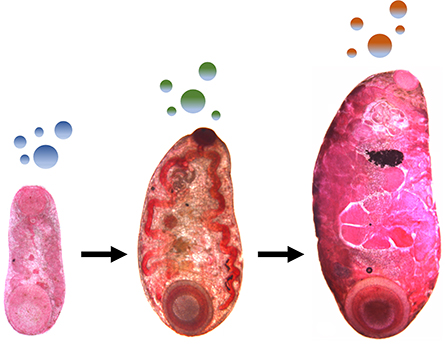Omics study unveils molecular mechanisms of a parasitic infection
Paramphistomes, also known as rumen or stomach fluke, are flatworm parasites that infect sheep and cattle in temperate and tropical regions. In recent years, the incidence and severity of rumen fluke infections (specifically the paramphistome Calicophoron daubneyi) have increased sharply in Western Europe. Heavy infections of immature rumen fluke in the small intestine can lead to hemorrhaging and even death, so early detection and correct diagnosis are imperative. However, researchers still know little about the biology of C. daubneyi and its effects on host animals.
Mark Robinson's lab at Queen's University Belfast focuses on parasitic worms and how they interact with their hosts at the molecular level. He has studied liver fluke for over 20 years. With the recent emergence of the less-studied rumen fluke in Europe (particularly in Northern Ireland, where his lab is based), his latest work shifted to understanding this unusual parasite and its host interactions. His findings, published in the journal Molecular & Cellular Proteomics, show how C. daubneyiregulates expression and secretion of certain molecules to establish infection, feed on host tissue and fight off the host immune response in ruminant livestock.

To begin to investigate the molecular biology of rumen fluke, Robinson's group teamed up with other researchers from the United Kingdom. Together, they performed transcriptome analysis of four rumen fluke life-cycle stages and integrated these results with proteomic analysis of secretions from two of these stages. They picked the juvenile flukes and mature adult stages for the proteomics studies, as these are the key stages responsible for acute and chronic disease, respectively.
Juvenile flukes emerge in the small intestine and eventually migrate along the digestive tract to the rumen, where they mature into adults. During each stage, the parasite must adapt to drastic changes in the host microenvironment and counter inevitable attacks by the host immune system. According to Robinson's findings, they do so easily.
"The rumen fluid is like a soup of bacteria and protozoans which the flukes must live amongst and survive," Robinson said.
Rumen flukes appear to secrete certain molecules that help them establish and maintain infection within this challenging host environment. Robinson likens the protective properties of these secreted molecules to those of the garments worn by astronauts: "Imagine stepping onto the surface of the moon without a space suit — you wouldn't last very long. Same goes for flukes within their host environments without their shield of secreted molecules."
Robinson believes the host–parasite interface can be adjusted to fight off infection. "If we can devise ways of blocking the secreted molecules, which are so important for the parasite, we may be able to come up with new treatment options," he said.
The lab has developed the first enzyme-linked immunosorbent assay for C. daubneyi, which they hope can be used by veterinarians, animal producers and farmers for disease surveillance and diagnosis. Next, Robinson wants to perform functional studies to validate certain molecules as targets for fluke control. As with all the work done in his lab, these efforts center on improving animal health and welfare, which he says is of benefit to everyone.
Enjoy reading ASBMB Today?
Become a member to receive the print edition four times a year and the digital edition monthly.
Learn moreGet the latest from ASBMB Today
Enter your email address, and we’ll send you a weekly email with recent articles, interviews and more.
Latest in Science
Science highlights or most popular articles

The science of staying strong
Muscles power every movement, but they also tell the story of aging itself. Scientists are uncovering how strength fades, why some species resist it and what lifestyle and molecular clues could help preserve muscle health for life.

Bacteriophage protein could make queso fresco safer
Researchers characterized the structure and function of PlyP100, a bacteriophage protein that shows promise as a food-safe antimicrobial for preventing Listeria monocytogenes growth in fresh cheeses.

Building the blueprint to block HIV
Wesley Sundquist will present his work on the HIV capsid and revolutionary drug, Lenacapavir, at the ASBMB Annual Meeting, March 7–10, in Maryland.

Gut microbes hijack cancer pathway in high-fat diets
Researchers at the Feinstein Institutes for Medical Research found that a high-fat diet increases ammonia-producing bacteria in the gut microbiome of mice, which in turn disrupts TGF-β signaling and promotes colorectal cancer.

Mapping fentanyl’s cellular footprint
Using a new imaging method, researchers at State University of New York at Buffalo traced fentanyl’s effects inside brain immune cells, revealing how the drug alters lipid droplets, pointing to new paths for addiction diagnostics.

Designing life’s building blocks with AI
Tanja Kortemme, a professor at the University of California, San Francisco, will discuss her research using computational biology to engineer proteins at the 2026 ASBMB Annual Meeting.

